Category: News & Events
Santa Fe Trail travelers pass through Lakin
It’s not every day you see a buckskin clad rider and his horse with no name traveling through Lakin. Oliver McCloskey of Cedar City, Utah, was on his 38th day of traveling when he stopped by the Kearny County Museum on July 19. The fur tanner and survivalist bought his horse at Fort Scott, Kansas and started out on June 12 to travel the Santa Fe Trail.
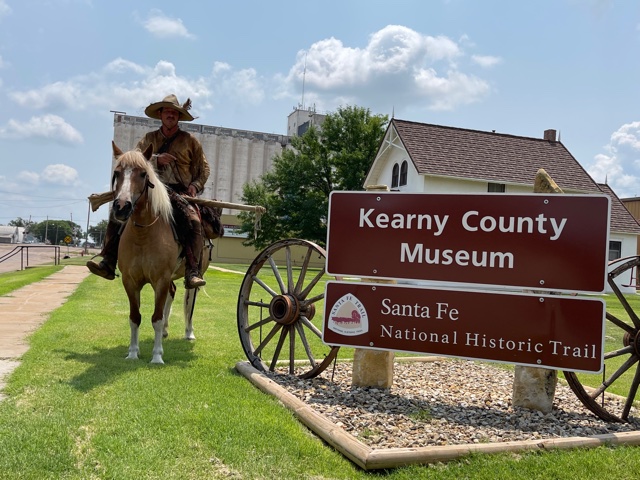 McCloskey is not new to this type of adventure. Last year he traveled the Oregon Trail. Since the first part of the SFT mirrors that of the Oregon Trail, McCloskey decided he would take up where he left off last year. After leaving Fort Scott, he joined up with the SFT at Canton. He will travel the original trail as much as possible, but just like the Oregon Trail, much of the SFT is not accessible.
McCloskey is not new to this type of adventure. Last year he traveled the Oregon Trail. Since the first part of the SFT mirrors that of the Oregon Trail, McCloskey decided he would take up where he left off last year. After leaving Fort Scott, he joined up with the SFT at Canton. He will travel the original trail as much as possible, but just like the Oregon Trail, much of the SFT is not accessible.
While on his journey, McCloskey will take in as many historical sites as possible. Friends can follow him and see pictures of his trek on his Facebook page. Averaging 15 to 20 miles per day, McCloskey takes turns riding and leading the horse. He said he usually walks about two miles for every 4 miles he rides in order to give the nine-year-old mare a break. Although he carries some water and food with him, Oliver said Kansans have been very generous offering sustenance for both he and his four-legged friend. McCloskey carries along a knife and long gun for protection as well as to forage up meals when needed. He sleeps next to his steed at night, usually under the stars and his saddle blankets. Thanks to the generosity of strangers, some nights they buck down in barns.
One might wonder why he hasn’t named his four-legged companion. McCloskey said he is a no-strings attached kind of guy and will sell the horse after his journey is complete. He said it is hard keeping a horse with his lifestyle because he is away from home so much of the time. The appaloosa he traveled on last year also did not have a name and was sold. “By the time the horses have traveled that many miles, they are broke in well and in high demand,” McCloskey said. He already has buyers lined up for “No Name” who said they would drive to Santa Fe with a trailer to pick the horse up when the duo’s journey is over.
A self-taught historian, McCloskey has published a number of ledgers and journals from the fur trade era. He not only made his clothing and shoes, but also his own saddle and a deerskin bag for his rifle. McCloskey gives tanning clinics and has been contacted about giving one in Hawaii in the near future.
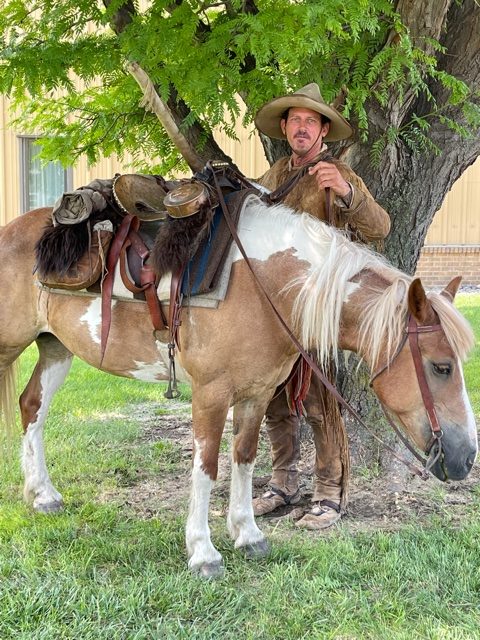

Summer activity turns youth into sleuths!
Summer scavenger hunts have returned to Kearny County Museum. This is a free activity for all children up to and including the age of 17. Children under the age of 12 must be accompanied with an adult who can help them solve the riddles! Each participant will receive a set of clues upon entering the Museum, and all the answers can be found in the Museum. 
All participants will receive a free old-fashioned candy stick. Those who correctly answer each riddle will be entered into a drawing for free prizes at summer’s end. There are three sets of clues so participants can be entered up to three times in the drawing.
Social distancing is required for this event. The hunt can be done Tuesdays through Fridays between 9 a.m. and 4 p.m. until July 30th.
A True Historian: Harold Smith
It is with great sadness that the Historical Society learned of the passing of former Kearny County Museum Director, Harold Smith. This article was written in 2014 by Dave Horner for the Museum’s newsletter. The Historical Society extends our deepest sympathy to Harold’s family and friends. We will long remember and appreciate Harold’s contributions as a member and employee of the Kearny County Historical Society.

Covid-19 continues to hamper events
At this time of year, the Kearny County Historical Society has typically either just had our annual meeting and election of officers or are planning the event. Due to concerns over Covid-19, the board decided not to have an annual meeting this year. While our county is currently in an Alert Level 1, as recently as two weeks ago we were at a Level 3. This meant that local health officers recommended decreased in-person interactions with others, necessary travel only, and limited attendance at gatherings of any number. Until Kearny County is consistently in a Level 1 and we learn more about the virus, KCHS activities will continue to look differently.
The Museum is open during regular hours, but we still have a mask mandate in place. This is because many of our visitors come from out of town, and we have no way of knowing whether they came from or traveled through an area of greater Covid infection. Rather than make exceptions to the rule for certain persons or groups, we have made face masks a blanket policy.
We also kindly ask visitors to maintain a safe distance from other guests, and displays are strictly hands off. Children under 12 must be accompanied by an adult and closely supervised. We continue to limit the number of visitors in the Museum and have not resumed guided tours.
Our greatest priority is our staff, volunteers, community AND collections. As conservators, we know that we must do no harm to historic artifacts and want our cultural resources to be here for future generations. Unlike hospitals, schools and other public buildings, many of our artifacts cannot be disinfected without compromising them.
Our board will periodically re-evaluate our policies, many of which have been adopted based on Museum Industry Standards. We appreciate your cooperation during this trying and uncertain time and hope that Covid-19 will be behind us soon so that we can safely return to business as usual.
GOD BLESS!
Tales of the Trail: buried treasure had ties to local man
Despite being laden with perils, the Santa Fe Trail was a pathway to wealth for many traders. In 1828 alone, $150,000 of merchandise was taken to Santa Fe. That same year, both danger and necessity led a caravan of traders to bury more than $10,000 of silver at Chouteau’s Island in Kearny County. The traders were returning to Missouri, and among the group was a man by the name of William Young Witt. Witt, a third cousin to the grandmother of lifetime Lakin resident B.C. Nash, kept notes about the tumultuous journey.
“After a few days’ rest, sight-seeing and purchasing stock to replace our own jaded animals, preparations were made for the return trip. All the money we had received for our goods was in gold and silver, principally the latter, in consequence of which, each member of the company had about as much as he could conveniently manage, and, as events turned out, much more than he could take care of.”
On the morning of the third day after leaving Santa Fe, the company’s entire herd was stampeded and they were left upon the prairie without as much as a single mule to pursue the thieves. While some remained to guard camp, others returned to Santa Fe to recover the stock which they had to repurchase “for there was no law governing those lawless bands that infested that country at that time.” The incident opened the party’s eyes to the treachery that awaited them. They kept up a vigilant guard both day and night eventually arriving at the Upper Cimarron Springs.
“One morning, just before dawn, the whole earth seemed to resound with the most horrible noises that ever greeted human ears; every blade of grass appeared to re-echo the horrid din. In a few moments every man was at his post, rifle in hand, ready for any emergency, and almost immediately a large band of Indians made their appearance, riding within rifle-shot of the wagon. A continuous battle raged for several hours,“ wrote Hitt. Though successful at stampeding all the horses and mules, the bows and arrows of the Indians were not enough against the gunpowder of the traders so the Indians retreated. Hitt was wounded six times. (According to fellow trader Milton E. Bryan’s account and Hitt’s son’s account, Hitt was wounded 16 times.)
The men soon realized the seriousness of their condition being 300 miles away from Santa Fe. The next morning some of them stayed in camp while Hitt and the others took off in hopes to find some of the lost stock. Upon his return to camp, Hitt was overtaken by Indians. While two held his legs, the other “plunged his hatchet, as he supposed, into my head, but instead of scuffling to free myself and rise to my feet, I merely turned my head to one side and the wicked weapon was buried in the ground, just grazing my ear.” Hitt escaped two more swings of the hatchet before some of his traveling companions arrived to rescue him. All the men returned to camp and took turns guarding the wagons through the night. Unable to secure any of their stock, they left by foot in the morning with each man shouldering a rifle and a proportion of provisions. They were not far when they spied smoke rising from the area of the camp. The Indians had set fire to their wagons.
After eight days travel, they had less than 100 pounds of flour left and had been unsuccessful in finding any game. Hitt recalled, “For two weeks the allowance of flour to each individual was but a spoonful, stirred in water and taken three times a day.” Adding to their futility was a scarcity of water. In desperation, the troupe was once compelled to suck the moist clay from a buffalo wallow. “Some became so weak and exhausted that it was with the greatest effort they could travel at all,” wrote Hitt.
As soon as a convenient camping ground was found, the men made shelter and left the weakest of their party while some of the strongest hunted. Successful at last in killing some small game and buffalo, they used buffalo chips to fuel a fire. After a few day’s rest, the men began again to march homeward, but their money had become a greater burden than they could bare. They decided to bury it at the first good place they came upon. “We came to an island in the river to which we waded, and there, between two large trees, dug a hole and deposited our treasure…This task finished, with much lighter burdens, but more anxious than ever, we again took up our march eastwardly.”
Traveling for over two weeks by foot, the men were exhausted; some scarcely able to move. They divided company, “one portion to press on, the weaker ones to proceed by easier stages, and when the advance arrived at the settlement, they were to send back a relief for those plodding on wearily behind them. Soon a few who were stronger than the others reached Independence, Missouri, and immediately sent a party with horses to bring in their comrades” who were seemingly nothing but human skeletons wrapped in rags, but “all got safely to their homes.”
Hitt is not mentioned as being among the men who returned to Chouteau’s Island the following spring and recovered the silver under the protection of the first military escort along the Santa Fe Trail. Sources: “William Y. Hitt Santa Fe Trail Memoires,” “The Old Santa Fe Trail” by Colonel Henry Inman, “Commerce of the Prairies” by Josiah Gregg, “The Flight of Time” by Milton E. Bryan, “Kansas Before 1854: A Revised Annals” compiled by Louis Barry, & ancestry.com with special thanks to Meg Nash Spellman.
200th Commemoration of the Santa Fe Trail
William Becknell, known as the father of the Santa Fe Trail, first traveled the trail in 1821. Many special events had been planned in 2021 to commemorate the trail’s 200th anniversary, but Covid-19 has hampered some of those events. Consequently, the Santa Fe Trail Association Board has expanded the commemoration of the historic trail to run from 2021-2025. This allows SFT chapters to safely schedule their events over the next few years. The focus will not only be on Becknell’s first trip but also subsequent trips made by Americans as well as Mexican traders who began shipping goods from Santa Fe and Mexico over the SFT to places further east. Visit http://santafetrail.org/ or http://santafetrail200.org for event dates and info.
No events have been planned in Kearny County at this time, but have a look at this video to learn more about points of interest on the trail in our county. You can also head over to our Fun & Games page (https://kearnycountymuseum.org/fun-games-for-young-pioneers-and-the-young-at-heart/) and print out some Santa Fe Trail activity sheets. Remember if you’re ever in Kearny County, we would love to have you drop by the Museum!
Local organization TOPpleS during Covid epidemic
While Covid-19 has affected many people, activities and businesses, one thing didn’t change when the New Year rang in. Many Americans once again made their yearly resolutions to lose weight. TOPS (Take Off Pounds Sensibly) has helped millions of people to take off and keep off pounds since its inception in 1948. Founded and headquartered in Milwaukee, Wis., TOPS promotes successful weight management with a philosophy that combines healthy eating, regular exercise, wellness education and support from fellow members.
The organization was the brainchild of housewife Esther S. Manz. Manz was pregnant with her fifth child and participating in group sessions designed to prepare women for childbirth where she witnessed the power of mutual support in helping women stay within their doctors’ guidelines for pregnancy. She contemplated a weight loss group with a similar philosophy and discussed it with her doctor who encouraged her to follow through with the idea. Championing weight loss support and success, TOPS grew to about 2,500 members in six states by 1951. Manz’s story appeared in LIFE magazine in April that year, and by the year’s end there were chapters in every state and a total membership of over 6,000. By 1955, TOPS had gone international and had given birth to KOPS. (Keep Off Pounds Sensibly)
Tumbleweed TOPS Chapter #278 was organized locally in November of 1967 with 19 charter members. Weekly meetings and weigh-ins were integral to the program. Tips for counting calories, meal plans, activities, guest speakers, and encouragement were keys to its success. Members were rewarded when they lost weight for consecutive periods of time: for example, four weeks of consecutive weight loss earned a charm, 10 weeks earned a bracelet and 12 weeks earned a necklace. Likewise, minimal fines were paid by those who gained weight. In the early years of the organization, the member who gained the most during the week would have a mandatory (but good-natured) penalty imposed such as wearing a “Porky” pig lapel pin for a week. In time, chapters were discouraged from this practice as national leaders felt it hurt the organization’s image and could be embarrassing or misconstrued as demeaning.
Bringing women together with the common cause of losing weight, TOPS created a camaraderie between its members. Contests, picnics, rallies, and coronations were all part of local chapter happenings. Members attended themed State Recognition Days and conventions and met with other TOPS chapters in the area for fun and fellowship. TOPS proved that working together to lose weight could be fun.
While TOPS looks forward to continued success on the national and international level, the local chapter decided to call it quits in 2020 due to the looming threat of Covid-19. According to Geneva Williams, the lone remaining charter member, the seven remaining members were also getting older and getting out and about was becoming difficult for them.
Williams received a 50-year certificate from the national office in 2017. She made many great memories (as well as dresses for Recognition Days) through the years. “The best thing about TOPS was the camaraderie. We always had a good time,” Williams said. Her favorite memory is when Lakin’s Mildred Yager was crowned queen of Kansas for losing the most overall weight in the state.
Scrapbooks, minutes and other artifacts of the local TOPS chapter were donated to the museum and will be put on display when the clubs and organizations section is revised and re-opened to the public.
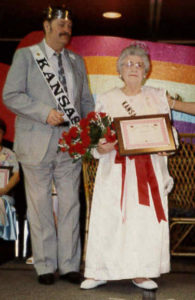
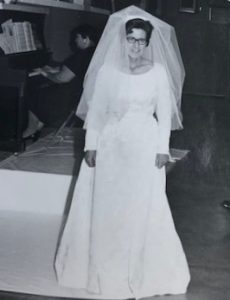
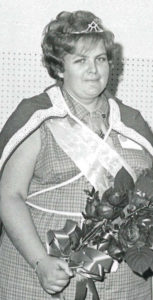
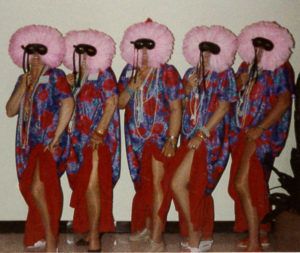
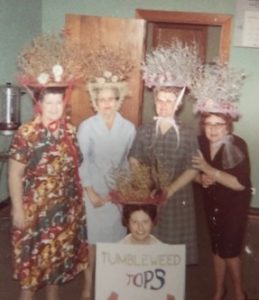
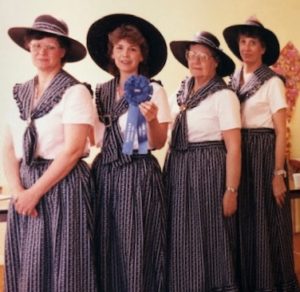
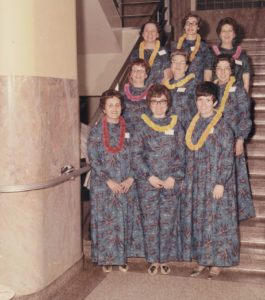
From the Winter 2021 newsletter. Want to see more of the newsletter? You can get your own delivered to your mailbox 4 times a year for a one-time membership fee of $20. Go to our membership page and complete the form today!
Kearny County Historical Society Kings & Queens – a 40-year tradition
Like many other activities in 2020, the 40-year-old tradition of crowning Christmas royalty fell victim to COVID-19. God willing, the event can safely resume in 2021, but until then, take a stroll down memory lane with our past kings and queens.
